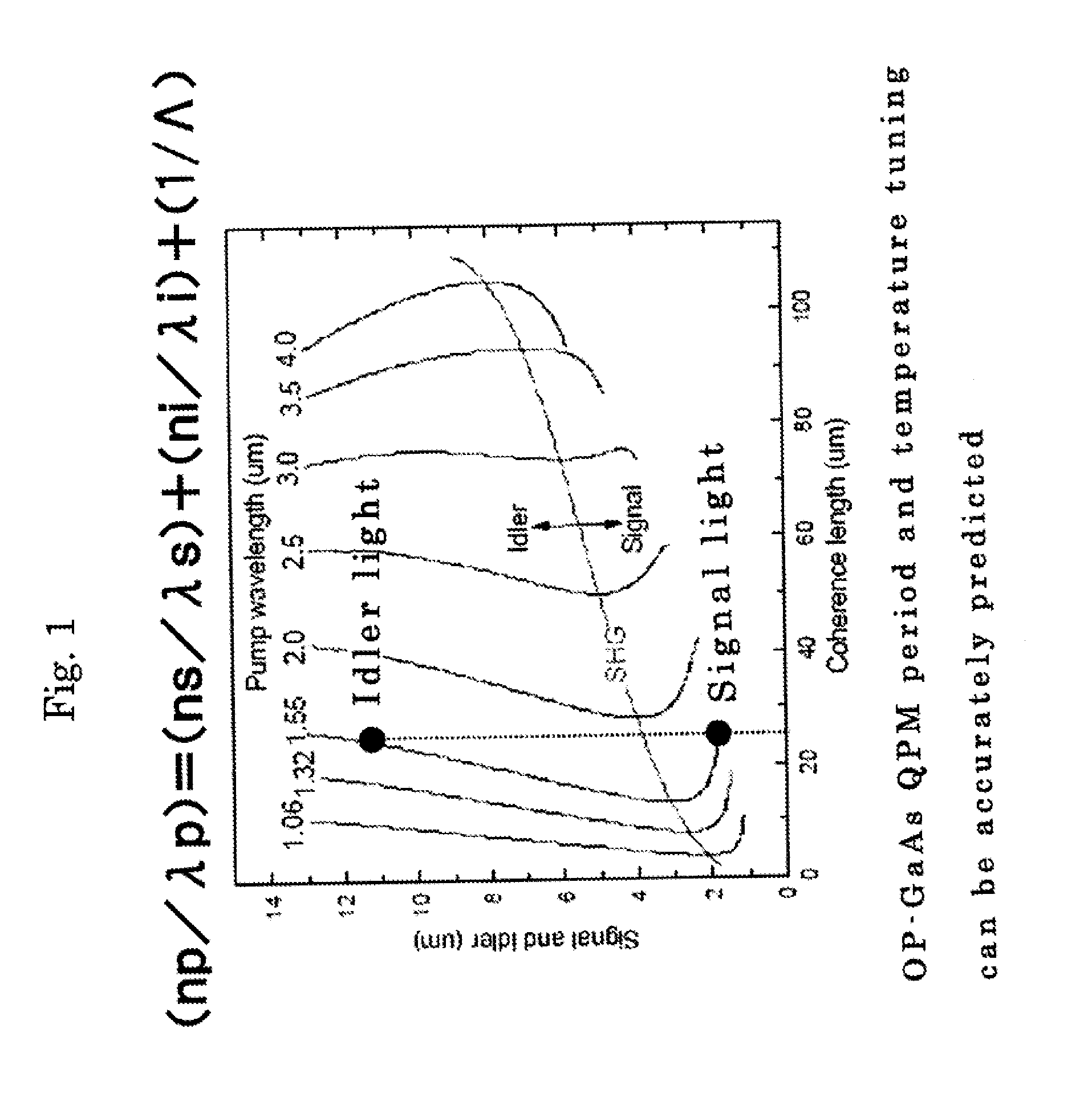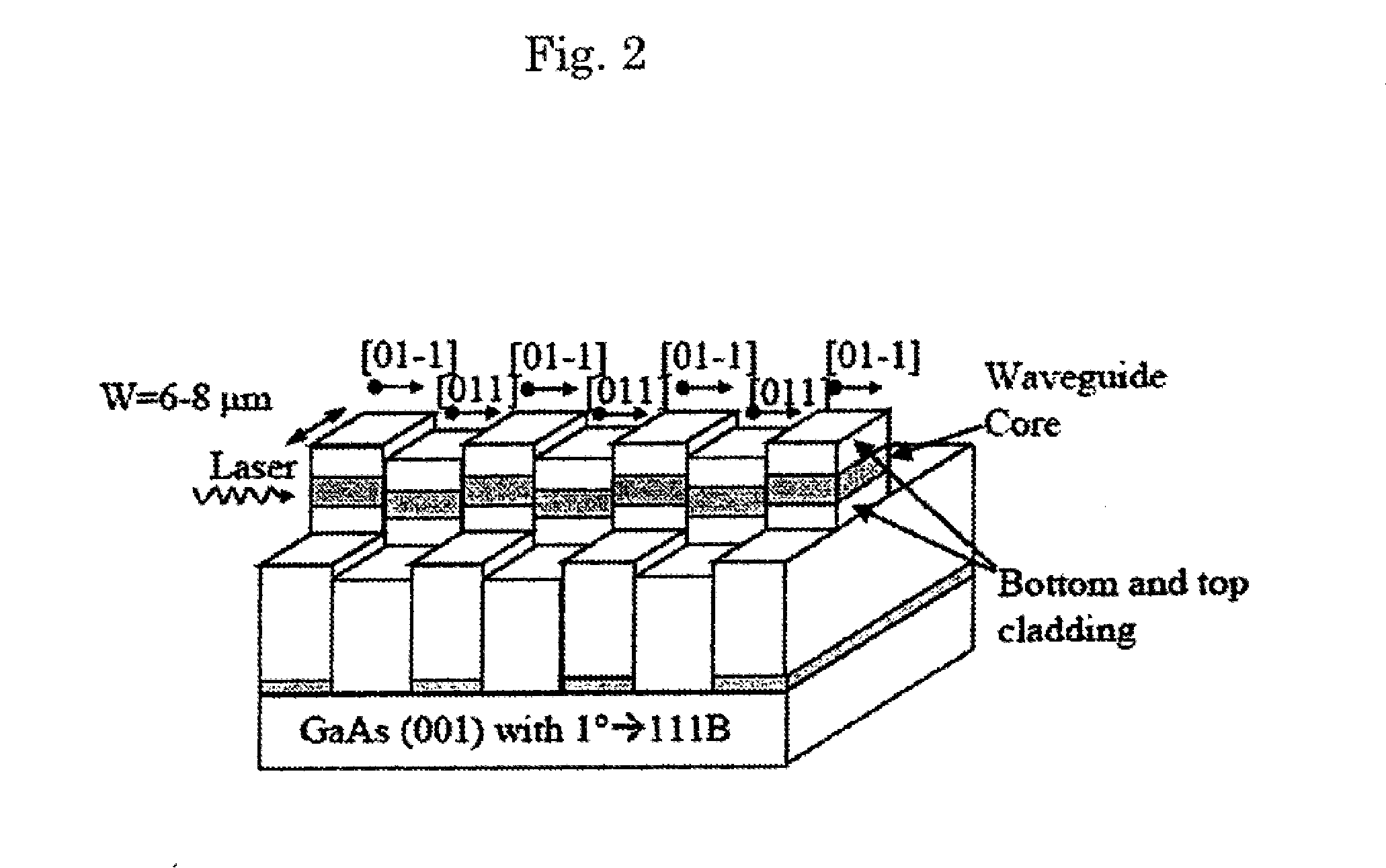Semiconductor Wavelength Converting Devices and Light Sources for Generating Infrared Rays
a technology of infrared rays and conversion devices, which is applied in the direction of optics, lasers, instruments, etc., can solve the problems of difficult to provide an optical waveguide of a low loss, observed roughness in the core portion, and increased propagation loss, so as to reduce the temperature distribution, and reduce the propagation loss of light.
- Summary
- Abstract
- Description
- Claims
- Application Information
AI Technical Summary
Benefits of technology
Problems solved by technology
Method used
Image
Examples
##ventive example 1
Inventive Example 1
[0074]It was produced the wavelength converting device described referring to FIGS. 3 and 4, and it was then assembled the resonator-type infrared ray generating device described referring to FIG. 6(b).
[0075]First, main physical properties of GaAs are shown below.[0076]Density: 5.316 g / cm3 [0077]Melting point: 1238° C.[0078]Thermal Expansion coefficient: 6.86×10−6 / K at 300° C.[0079]Thermal Conduction: 55 W / m·K[0080]Dielectric constant: 11.53, 10.10 (ε0, ε∞)[0081]Refractive Index: 3.3 to 3.7
[0082]Specifically, as shown in FIG. 7, it was prepared a 2-inch OP-GaAs wafer 12 having an inversion period Λ of 58 μm. The wafer was then adhered onto a glass wafer 2 having a thermal expansion coefficient of 7 ppm / ° C. and a thickness of 0.5 mm through an adhesive layer 4 having a refractive index of 1.9 (made of Cardo polymer). The thickness of the adhesive layer was made 0.5 μg. Next, the thus adhered OP-GaAs wafer was then adhered onto a surface plate and the GaAs wafer s...
##ventive example 2
Inventive Example 2
[0087]The device 1 shown in FIGS. 3 and 4 was produced according to the same procedure as the Inventive Example 1.
[0088]Then, as shown in FIG. 6(a), the single path type infrared ray generating system was assembled.
[0089]Specifically, the OP-GaAs device with the end faces polished was mounted on the Peltier device as shown in FIG. 6(a) and a DFB laser 20 was operated at a wavelength of 1874 nm, 3 nsec and 10 μJ. Near-infrared rays (pump light) having a spectrum line width of 1 GHz was condensed with a lens and then input into the GaAs device. The orientation of the polarization of the pump light was in a crystal axis of (110). It was thus generated the idler light of a wavelength of 7333 nm whose orientation of polarization was in a crystal axis of (001). The output power was 200 nJ and spectrum line width was 2 GHz.
[0090]Further, the temperature of the Peltier device was elevated to 150° C. and it was thus proved that the wavelength of the idler light was gradual...
##ventive examples 3 and 4
Comparative Example 2 and Inventive Examples 3 and 4
[0094]FIG. 9 shows a system of generating infrared rays disclosed in the Non-Patent Reference 3 by Stanford University. Pump light P1 of a wavelength of 1.3 μm and signal light P3 of a wavelength of 1.55 μm were made incident into the wavelength converting device having the GaAs bulk same as the Comparative Example 1. The thus generated idler light was then passed through a Ge filter and outputted. The wavelength λi of the idler light was about 8 μm and output power was 114 nW.
[0095]On the other hand, the GaAs bulk device of the comparative Example 2 was replaced with the device 1 used in the above described Inventive Example 1. The output power P2 and conversion rate η of the thus obtained idler light were shown in table 2, in which “L” indicates the length of the device.
TABLE 2P1P3Lη(W)(W)(cm)(% / Wcm2)P2Comparative0.0033128.6 × 10−4114nWExample 2Inventive0.050.0520.770μWExample 3WaveguideInventive0.10.14Type1mWExample 4
[0096]As de...
PUM
| Property | Measurement | Unit |
|---|---|---|
| wavelength | aaaaa | aaaaa |
| thickness | aaaaa | aaaaa |
| wavelengths | aaaaa | aaaaa |
Abstract
Description
Claims
Application Information
 Login to View More
Login to View More - R&D
- Intellectual Property
- Life Sciences
- Materials
- Tech Scout
- Unparalleled Data Quality
- Higher Quality Content
- 60% Fewer Hallucinations
Browse by: Latest US Patents, China's latest patents, Technical Efficacy Thesaurus, Application Domain, Technology Topic, Popular Technical Reports.
© 2025 PatSnap. All rights reserved.Legal|Privacy policy|Modern Slavery Act Transparency Statement|Sitemap|About US| Contact US: help@patsnap.com



